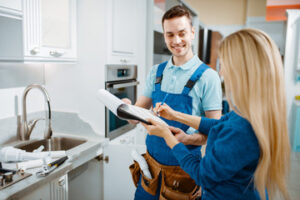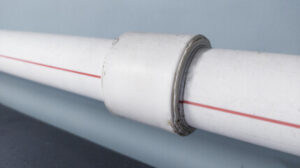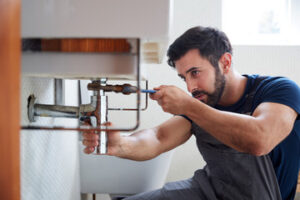Plumbing emergencies don’t always happen at a convenient time. Unattended, they can lead to costly damage and discomfort.

Plumbers In Topeka will diagnose the problem quickly and find a solution that is both cost-effective and safe for your family. They will also implement temporary repairs and provide recommendations for permanent fixes.
A burst pipe can be a serious problem that threatens the safety of your family and can cause extensive water damage. In addition, it can lead to mold growth and other costly structural issues. This is why it is important to know how to spot a pipe that may be bursting so you can call an emergency plumber right away.
There are several things that can cause a pipe to burst, including freezing temperatures, age, and environmental factors. In general, pipes are more likely to burst in cold climates because the water inside them will freeze and expand, putting pressure on the pipe walls. If the pipes are older or located in unheated areas of the home, they are also at higher risk for bursting.
If you suspect that one of your pipes has burst, the first thing to do is shut off the water. This will prevent as much water damage as possible while you wait for the emergency plumber to arrive. You can usually find the water valve near where the pipes enter your home or at the lowest point of your property’s plumbing system. Once you have turned off the water, you should also try to locate any standing water in your home and remove it as quickly as possible.
Once the water is removed, it’s important to assess the damage and take steps to repair or replace the affected pipes. This is where an experienced emergency plumber can really come in handy. They will be able to determine what caused the pipe to burst, and they can recommend the best course of action for repairing or replacing it.
A burst pipe can cause extensive water damage that could cost you thousands of dollars to repair. It can also lead to the development of mold, which is a health hazard for your family and can create a musty smell throughout your home. If left untreated, mold can also cause respiratory problems and other health conditions.
When you need an emergency plumber, it’s important to take the time to find out what services they offer and how much they charge for them. It is also a good idea to find out whether your homeowners insurance covers the costs of water damage and how to file a claim. By following these tips, you can ensure that you hire an emergency plumber who will provide high-quality service and repair or replace your damaged pipes in a timely manner.
Sewer Backups
The aging of the nation’s plumbing system coupled with the sheer number of homes being built are creating an ever-increasing chance for sewer line backups. The good news is that you can prevent these issues if you know the signs to look for. If you notice that it’s taking longer for water to drain from your sinks, toilets or tubs, hear gurgling sounds when flushing the toilet or see that wastewater is backing up into your shower or bathtub, call an emergency plumber right away. These are all indicators that your home’s sewer line is experiencing a problem and could be about to back up into your home.
A sewage backup can cause extensive and expensive damage to your home. It can also pose a health risk, as raw sewage contains dangerous bacteria that can make you sick. If you experience a sewage backup, it’s important to turn off your home’s main water supply and contact your local utility department immediately.
If you’re not sure whether or not your sewer line has backed up, start by checking the lowest drains in your home first, such as those in the basement or the bathroom floor drains. If you’re unable to find the source of the problem, call your emergency plumber and describe the situation to them. They will be able to diagnose the issue and determine if it is an emergency plumbing situation or if you can wait until normal business hours.
In some cases, the root of the problem is beyond your control, such as a blockage in the city sewer system or a collapsed sewer line that you share with your neighbors. If this is the case, your emergency plumber will help you file an insurance claim and work with the municipality to get the problem fixed.
Thoroughly disinfecting your home after a sewage backup is crucial to protect your family’s health and to limit the amount of water damage that occurs in your home. You can do this by removing any contaminated materials and using a registered disinfectant that’s designed to kill pathogens in sewage and waste.
Water Leaks
Regardless of whether they’re caused by a clogged drain, a water heater malfunction, or even an old pipe that’s simply corroded over time, water leaks are one of the most common causes of emergency plumbing issues. And while minor leaks may seem harmless enough, they can quickly lead to significant damage if left unchecked.
Fortunately, there are many things you can do to prevent or mitigate the effects of a water leak. These include switching off the main water supply, which can be done by turning off your home’s stop cock or valve. You should also switch off any appliances using water, such as washing machines, dishwashers and toilets. And don’t forget to check the water meter. If you notice that the meter is still changing, even after all of your appliances are switched off, this could be a sign of a water leak.
Water leaks can be difficult to detect, especially if they’re located within walls or underneath floors. However, there are some signs you should look out for that can help you spot a leak before it’s too late. These include dark spots on ceilings or walls, sagging floors or ceilings, and even increased water bills.
Some leaks are more severe than others, but all should be fixed as soon as possible to avoid costly repairs and water waste. Leaks from leaking joints, cracked or broken pipes, and faulty fixtures can all cause major problems if not addressed immediately.
If you think you have a water leak, it’s important to find an emergency plumber with a good reputation and plenty of experience. Before hiring anyone, it’s worth checking online reviews and testimonials.
Water leaks can be very damaging to your home and health, so it’s vital to call an emergency plumber as soon as you suspect a problem. Getting an experienced plumber to fix the issue as quickly as possible will ensure that the issue doesn’t worsen over time. This will save you money on repair costs and keep your home safe and healthy.
Commercial Plumbing
Commercial plumbing is responsible for delivering clean water and removing waste, and it is essential to the day-to-day operations of any business. When a plumbing emergency occurs, such as a burst pipe or clogged drain, it can disrupt operations and result in extensive damage. This can lead to lost revenue and unhappy customers, so it is important to have access to emergency plumbers that are trained to respond quickly and effectively.
Emergency plumbers are experienced in dealing with large-scale plumbing issues and understand the unique intricacies of commercial systems. They can quickly identify and repair the problem, and provide solutions that are tailored to the needs of a business. This helps to minimize downtime and avoid costly damage to property and inventory.
When a plumbing emergency occurs in your office or store, the first thing you should do is shut off the main water supply to prevent further damage and potential flooding. It is also a good idea to move any valuable items to safety and remove any electronics that may be affected by water damage. Lastly, it is important to document the extent of the damage for insurance purposes and future reference.
If a significant amount of water has been displaced, it is essential to contact emergency plumbers right away. They can use special equipment to assess the damage and implement measures to mitigate it. They can also install high-capacity pumps to restore water flow and prevent further flooding. Additionally, they can create temporary repairs to keep your business running while a permanent solution is arranged.
Many people are not sure which emergency plumber to call when they have a plumbing problem. They may choose the first one that responds to their call, but this can often be a mistake. To save yourself time and money, you should always research emergency plumbers before hiring one. There are many websites that allow you to compare different companies and read reviews from previous clients. You should also ask your friends and family for recommendations.
Having a reliable emergency plumber can make all the difference in a plumbing crisis. Choosing the wrong plumber could end up costing you more in the long run, so it is vital to do your homework before making a decision.



